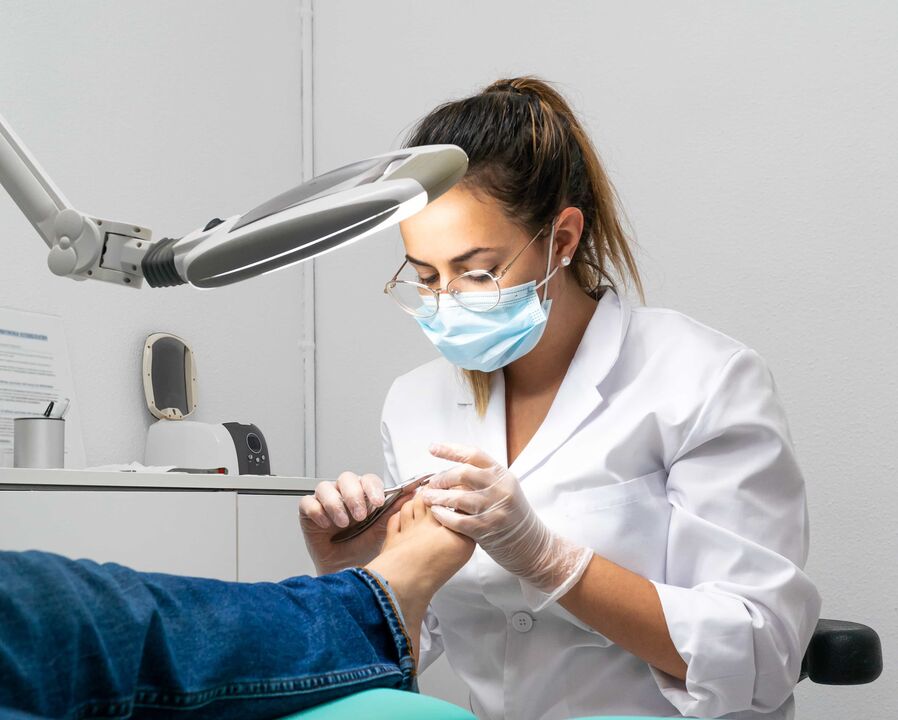Nail fungus is diagnosed in 20-30% of people. Pathology is more difficult to treat than fungal infections of the skin. To get a good effect from the therapy, it is recommended to use systemic and local antifungal drugs for 18 months or more. In some cases, repeated therapy is necessary.

Causes of fungal infections on the nail plate, classification, pathogenesis
Onychomycosis is an infectious pathology that manifests itself as damage to the nail plate due to the penetration of fungal flora. It can occur on both fingernails and toenails.
Damage to the nail plate is caused by the following pathogens:
- foot damage - dermatomycetes, candida albigens, non-dermatomycete molds;
- fingernail fungus - dermatomycetes, C. parapsilosis, mold fungus agent.
The nail complex can be affected by one fungal agent or 2-3 types of pathogens at the same time.
Factors that provoke pathology:
- age over 50 years;
- long-term work in hazardous work that worsens the immune status;
- regular sweating on the feet due to improper selection of shoes;
- traumatic damage to the nail complex, which stimulates the inflammatory process and the proliferation of pathogenic microbes;
- immune deficiency that triggers tumor processes, autoimmune diseases, diabetes mellitus and other conditions;
- nail plate dystrophy in dermatological diseases.
All these factors can cause the appearance of fungal infections.
Symptoms and stages of pathology in adult patients
Onychomycosis is localized on the fingers or toes. The clinical picture of this disease is shown by changes in the color, transparency and shape of the nail plate. Symptoms of fungal infection may vary depending on the type of pathology. The following types of onychomycosis are distinguished:
- Marginal damage is the first initial stage of pathology, caused by the entry of pathogens from the outside; barely noticeable changes in the nail plate appear in the area of its free part, not adjacent to the nail bed; yellowish gray stripes and patterns (areas of nail abrasion) are observed.
- Normotropic variety - the nail plate has stripes or sectors of damage, but at the same time maintains its original thickness and shape; nails become brittle and acquire a yellow-gray color; the plate becomes thinner and grows more slowly.
- Hypertrophic appearance - observed in patients who do not treat onychomycosis; the nail plate thickens either in the area of the free part of the nail or in the place of the nail fold; They also highlight the complete damage to the plate, when it evenly changes color, transparency and thickness.
- White superficial variety - occurs more often after prolonged therapy with systemic antifungal drugs; appears as a whitish or yellowish opacity on the surface of the nail.
- The appearance of proximal deformation - the nail plate takes a wave-like shape (similar to a washboard), the color and transparency remain the same.
- Various onycholiths - plates become fragile, fragile, thin; occurs on the background of hypertrophic or normotrophic onychomycosis.
- Atrophic type - nail thinning, brittleness; appears when the plate is frequently polished.
Based on the clinical picture, the doctor determines the type of pathology, makes a diagnosis, and prescribes therapy.
Fungal manifestations in childhood
Symptoms of onychomycosis in children are most often observed when the skin of the feet and hands is affected by the fungus. Nail changes:
- The normotropic type of disease is shown by the degeneration of the plate with its normal thickness and shape. The nails of young patients become streaked, dull, and have a whitish yellow color. The plate is starting to peel off in the base area.
- Mycotic leukonychia - looks like precise spots that merge over time and cover the entire surface of the nail.
- Atrophic and onycholytic types - nails begin to separate from the nail bed and shorten.
- Distal-lateral mycosis - brown transverse furrows appear (tunnels created by the pathogen).
Hypertrophic and proximal types of disease (wavy deformation) are rare in children.
Advanced nail fungus - what are the possible complications?
The infection can spread to all parts of the body (neck, torso, arms, legs), if the patient has reduced immunity or has a chronic disease (diabetes mellitus, thyroid pathology). The general course is provoked by the prolonged absence of treatment.
Deformation of the nail is often accompanied by its growth into the lateral folds of the nail bed. This pathology requires surgery, as it causes severe pain and swelling.
Which doctor should I go to for nail fungus?
If symptoms of onychomycosis appear, it is recommended to visit a doctor. The doctor will carry out an examination and refer you to a dermatologist or podiatrist. You can not treat the disease yourself or ignore the symptoms of the disease, because this can cause serious deformation of the nail plate. Significant changes in the shape of the nail require surgical treatment.

Diagnostic method
To make a diagnosis, it is necessary to confirm the presence of fungal agents in the nail plate. For this purpose, the microscope method is used. A piece of material is taken from the patient from the free part of the nail, the plate itself, and the subungual zone. If a pathogen is identified, the material is sampled again for testing. If the fungus is detected again, therapy is started.
In some cases, seeding is indicated. It is done more often after a course of therapy. Cultures show the ability of the fungus to cause relapse.
In addition to culture and microscopy, before antifungal therapy, patients may be prescribed:
- general blood test, urine test,
- liver enzymes,
- alkaline phosphatase,
- bilirubin,
- TSH.
These studies will help identify chronic diseases and prevent possible complications from taking medication.
How do podiatrists or dermatologists treat nail fungus?
Nail fungus treatment should be carried out on time. Therapy is prescribed after diagnosis. To increase the effectiveness of the treatment, you must follow all the doctor's recommendations. Otherwise, there is a high probability of disease recurrence.
Complex therapy includes systemic drugs that treat nail fungus, as well as local drugs that help relieve symptoms more quickly.
Systemic therapy consists of antifungal drugs used in the form of tablets and capsules. They penetrate the bloodstream, killing the fungal agent from the inside. Systemic therapy, taken correctly, prevents relapse, because it stops the source of infection.
Local preparations are applied directly to the nail plate. They improve the appearance of nails, kill fungal spores locally, and promote rapid renewal.
In addition to local and systemic therapy, surgical or cosmetic correction is indicated in advanced cases. Surgical treatment is prescribed more often for inflammation after the growth of the nail plate. Cosmetic correction is used when nails are severely deformed.
Attention! Nail fungus cannot be treated with folk remedies. This can cause complications.
The most effective remedy for fungus
Local therapy is less effective, so it is often combined with systemic drugs. Topical medications for nail fungus include:
- ointment,
- cream,
- varnish.
To use topical medication, you must first remove the affected part of the nail plate. For this purpose, keratolytic patches are indicated. They are divided into:
- Urea.
- Salicylic (Quinozolo-salicylic patch, Quinozolodimexide patch).
Sometimes the affected nail plate is removed by cleaning (hardware removal with a diamond cutter and other methods).
After removing the affected nail, local therapy begins. If the nail plate is preserved after softening or mechanical cleaning, apply varnish. The most common in this group of external agents are drugs with the following ingredients:
- Amorolfine, indicated for application twice a week; The course of therapy is six months (hands), one year (legs).
- The active ingredient is ciclopirox; used daily in the first month, then in the second month of therapy it is indicated once a week; the course lasts up to six months.
In addition to varnish, it is allowed to use creams and ointments. Effective ingredients:
- Clotrimazole in the form of ointment or cream;
- Bifonazole - in the form of cream, spray;
- Ketoconazole and other drugs.
Ointments or creams for nail fungus that contain the ingredient Terbinafine are often used. The effectiveness of this product is quite high.
Prediction
The prognosis for timely treatment is good. Correctly prescribed therapy can completely eliminate the symptoms of the disease. If the pathology is not treated, severe deformation of the nail plate and the spread of infection to the skin are possible.
How to prevent the occurrence of pathology
Onychomycosis can be prevented by following simple hygiene rules. It is recommended to shower every day and dry your feet thoroughly with a towel. You should clean the bathroom or shower with an antiseptic solution and change clothes (especially socks and tights). Products containing chlorine are recommended for treating wet rooms.
It is advisable to avoid visiting public baths and saunas, or bring personal shoes with you, which will reduce the possibility of infection. For prevention, it is permissible to use an antifungal spray after the visit.
Pathogens can be contracted at the beach. Therefore, after a beach vacation, you should wash your feet, treat them with antifungal spray or other external preparations.
You should not wear other people's shoes or socks - this can be a source of infection. When trying on shoes or boots in the store, you must put on ankle boots or socks (and then immediately put them in the wash). Be sure to use an antifungal spray to prevent infection.
You should choose shoes according to the weather. Feet should not sweat. The size of the boots or shoes must be appropriate so that the feet are not pinched. Excessive stress and trauma trigger the proliferation of fungal agents. If a family member has been diagnosed with fungus, the whole family needs to be treated at the same time.
Fungi cause reduced immunity. For this reason, chronic diseases (diabetes mellitus, thyroid pathology, immunodeficiencies, ENT diseases) should be treated in a timely manner.
Today, onychomycosis is treated quite successfully. The pharmacy has a large warehouse of antifungal drugs, both systemic and local. Treatment should be prescribed by a doctor to prevent complications and recurrence of pathology. Lamisil can be used as a universal option.
How to treat toenail and toenail fungus with Terbinafine?
Terbinafine can cure nail fungus and is found in many medications. It is available in cream, spray and tablet form. Various forms of medicine allow you to treat nail fungus at home.
Systemic therapy is indicated with 250 mg tablets once a day for 12 weeks. Along with the tablets, you need to apply the cream to the affected area twice a day. The course of local therapy is up to 2 weeks or more. It is better to use the cream until the nail is completely renewed.























